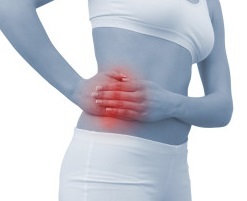 The appendix, lat. appendix vermiformis is a vermiform appendix, 5-7 cm long (sometimes 20 cm), 1 cm in diameter, blindly terminating, tubular.
The appendix, lat. appendix vermiformis is a vermiform appendix, 5-7 cm long (sometimes 20 cm), 1 cm in diameter, blindly terminating, tubular.
Exacerbation of appendicitis can occur at any age. Risk groups are children over 5 years, adults 20-30 years, pregnant women. Pathology is equally characteristic of the female and male sex. Very rarely appendicitis occurs in young children, which is explained by the age-related anatomical feature of the appendix, which has the shape of a funnel and is easily emptied, and a weak development of the lymphoid apparatus of the appendage.
Among all diseases of the abdominal cavity, which require immediate surgical intervention, appendicitis is the most common. If an attack of acute appendicitis occurs, you need to call an ambulance in the shortest possible time. If appendicitis is not treated, peritonitis can develop - a complication that leads to death.
How appendicitis manifests, the symptoms and signs of this emergency must be known to every person. The main symptom of appendicitis in adults and children is pain. It occurs in the upper part of the abdomen or near the navel, sometimes it is impossible to specify the place of pain ("the whole stomach hurts"). Then the pain moves to the right side of the abdomen. Such a migration of pain is considered a very specific symptom of the disease
Causes of appendicitis
The following causes of inflammation of the appendix are distinguished:
- Combination of mechanical obstruction of the lumen of the appendix and activation of the intestinal microflora. Occlusion can be caused by stool stones, enlarged lymphoid follicles, foreign body (accidentally swallowed), tumor formation, congestion of parasites. In the place where such a "plug" appears, mucus accumulates, and microorganisms actively multiply. Inside the lumen, the pressure is increased, the blood vessels are squeezed, the outflow of blood and lymph is disturbed. Result: inflammation and necrosis of the appendix.
- According to some reports, the risk of appendicitis is higher in persons suffering from stool delay for many years. Due to the slow movement of stools through the digestive tract, such people often have stool stones.
- The same can be said about those people whose diet is saturated with protein food and is poor in plant fiber. Fiber facilitates the movement of intestinal contents, improves the work of peristalsis.
- The vascular theory suggests that systemic vasculitis (vasculitis - inflammation of the vascular wall) is the cause of appendicitis development.
- Infectious theory has not received any confirmation or refutation. It is believed that some infectious diseases (for example, typhoid fever) are capable of provoking the development of appendicitis.
Which side of appendicitis?
The appendix is a small process of the cecum. In most people, it is located on the right side of the abdomen, below the navel. On what side of appendicitis a person can affect the state of the intestine. If appendicular peritonitis develops then the symptoms are pronounced bright and acute, the localization of appendicitis pains with as a rule the right side, it is characteristic for the development of an acute inflammatory process in the patient's body, which requires not emergency medical care and surgery to remove the appendix.
Appendicitis can be differently located in the peritoneal region, which does not give an unambiguous picture in the localization of symptoms, pain can be given both in the right side and in the lumbar region, or in the pelvic area, the sexual organs of the patient. The nature of the pain sensations has a different intensity, amplifying or abating, cramping, can last as a long time or for a short time.
Signs of appendicitis
There are many different signs of appendicitis in adults and children. Signal of the onset of the disease is severe pain. At the very beginning, it does not have a relatively clear location. A person may feel that his stomach is just hurting. However, after 4-5 hours, the pain concentrates closer to the right ileal region.
It is worth noting that the appendix in different people can be placed in different ways, it all depends on the structure of the body. In case the process has a normal position, the pain will be observed in the right ileal region. If the process is slightly higher, the pain will be on the right under the ribs. Well, if the process is down, it will hurt in the pelvic area. Among other things, the patient can be bothered and vomiting, and in some cases, diarrhea.
Among other popular signs of appendicitis can be noted the following: dry tongue, darkening of urine, fever, which can reach 40 degrees, pregnant women may experience increased pain during a turn from left to right.
Symptoms of appendicitis
 In the case of acute appendicitis, the symptoms are pronounced. There is an attack of pain in the right iliac region, expressed by the local and general reaction of the body. As a rule, pain with acute appendicitis begins suddenly.
In the case of acute appendicitis, the symptoms are pronounced. There is an attack of pain in the right iliac region, expressed by the local and general reaction of the body. As a rule, pain with acute appendicitis begins suddenly.
At the beginning of the attack, they are often localized in the epigastric region, in the navel or throughout the abdomen, and after a few hours (sometimes 1-2 days) in the right iliac region. More often pains are permanent in nature, they do not irradiate anywhere, but intensify with coughing. Pain in the abdomen does not allow the patient to fall asleep, but its intensity is usually low; characterized by a reduction in pain in the position on the right side.
In the first hours of the disease, nausea and vomiting may occur. Stools and gases are often delayed. Significantly less frequent liquid bowel movements (mainly with severe intoxication). Body temperature rises to 37.5-38 °, rarely remains normal. Pulse in the first day from the onset of the disease is increased to 90-100 beats per minute, BP does not change and only slightly decreases when heavy intoxication occurs. The tongue is slightly lined and moist at first, but it soon becomes dry.
Also, with appendicitis, there are other symptoms. For example, when examining the abdomen, lag often is determined when breathing the lower abdominal wall. Palpation of the abdomen should be done carefully, starting with the left half. At the same time, in the right ileal region, as a rule, sharp soreness is observed, combined with the protective tension of the muscles of the abdominal wall in a limited area. In most patients, slight tapping with fingers in various areas of the abdominal wall helps to quickly establish the place of the greatest soreness.
However, not always the symptoms and the course of acute appendicitis are so characteristic. Particularly peculiar can be the clinical picture of the disease in children, persons of elderly and senile age, and also at an abnormal location of the appendix. In any case, if you have symptoms similar to appendicitis, you need to call an ambulance.
Chronic appendicitis occurs with aching blunt pains in the right ileal region, which can periodically increase, especially with physical stress.
Signs of appendicitis in women
To the inflammation of appendicitis, the slopes are larger than women, the symptoms of which appear more often at the age of twenty, forty. This is due to the physiological structure of the female body, the pelvis, so it can flow in a different way. Especially the symptoms of appendicitis in women during pregnancy are different. Since the appendix is located near the right appendages of the uterus, signs of inflammation occur more often twice than in the male population.
- When palpation, women have painful sensations, which speaks of inflammation of the abdominal cavity.
- If you press the point below the navel in a woman, then there may be pain, which is worse when you get up, which indicates involvement in the inflammatory process of reproductive organs.
- When examining the vagina in a woman, there is pain, especially when examining the cervix, with appendicitis indicating inflammation of the appendages.
When diagnosing and diagnosing a woman is tested not only the condition of the appendix, but the condition of the genital organs as a whole.
Diagnostics
The diagnosis is based on the characteristic symptoms of appendicitis. Confirm the diagnosis of "inflammatory signals" of a general blood test. The most reliable method is laparoscopy.
Clarification of the morphological form of appendicitis (catarrhal, gangrenous, phlegmonous) is possible with surgical intervention: a histological examination of the appendectomy is performed. From instrumental methods, ultrasound, radiography of the abdominal cavity, irrigoscopy, computed tomography are used.
Treatment
The usual tactic for acute appendicitis is as early as possible surgical removal of the inflamed vermiform appendage. After 36 hours from the appearance of the first symptoms, the probability of perforation (rupture) of the appendix is 16-36% and increases by 5% every 12 hours. Therefore, after confirmation of the diagnosis, the operation should be performed without too much delay.
At the stage of prehospital care, suspicion of acute appendicitis shows bed rest, the exclusion of fluid and food intake, and the application of cold to the right iliac region. Categorically forbidden intake of laxatives, the use of warmers, the introduction of analgesics before the final diagnosis.
Currently, with a simple form of appendicitis, laparoscopic surgery, which does not require an incision of the abdominal wall, is preferred. In this case, the endoscopic instrument is inserted into the abdominal cavity through a small puncture in the tissues. Removal of appendicitis in this way allows to avoid an operational trauma, and to shorten the recovery period at times. The risk of developing postoperative complications with appendicitis removal by laparoscopic method is minimal.
In the case of chronic appendicitis, appendectomy is indicated, if persistent pain syndrome is observed, depriving the patient of normal activity. With a relatively easy symptomatology, conservative tactics can be applied, including the elimination of constipation, the use of spasmolytic drugs, and physiotherapy.

How to choose probiotics for the intestine: a list of drugs.

Effective and inexpensive cough syrups for children and adults.

Modern non-steroidal anti-inflammatory drugs.

Review of tablets from the increased pressure of the new generation.
 Antiviral drugs are inexpensive and effective.
Antiviral drugs are inexpensive and effective.



